
- Usage in publication:
-
- Seneca limestone
- Modifications:
-
- Overview
- AAPG geologic province:
-
- Appalachian basin
Summary:
Unit described as fine-grained, compact, often brittle. Contains thin layers and nodules of hornstone and a shaly stratum. Succeeds the gray crinoidal Onondaga limestone and in some instances alternates with it. It is recognized by its darker-blue color, fine texture, and homogeneous structure. Generally very brittle. Unconformably underlies Marcellus shales.
Source: GNU records (USGS DDS-6; Reston GNULEX).
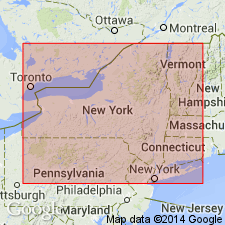
- Usage in publication:
-
- Seneca limestone
- Modifications:
-
- Named
- Dominant lithology:
-
- Limestone
- AAPG geologic province:
-
- Appalachian basin
Summary:
Seneca limestone, [here named], is nearly black from carbonaceous matter. First encountered in Seneca Co., where it is separate from all other masses of limestone. Rests on 15 to 20 ft of black brittle limestone terminated by one or two layers containing nodules of flint. Author states, "* * * the layers below the flint I understand are the true 'cornitiferous rock' of Prof. Eaton." The Seneca is overlain by pyritiferous slate, slaty shale, and sandstone.
Source: GNU records (USGS DDS-6; Reston GNULEX).
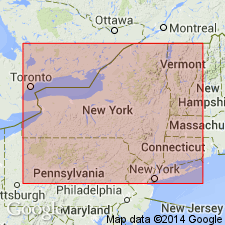
- Usage in publication:
-
- Seneca limestone
- Modifications:
-
- Overview
- AAPG geologic province:
-
- Appalachian basin
Summary:
Unit underlies Marcellus shales and rests on Corniferous limestone. It is terminal part of Corniferous limestone, which rests on Onondaga limestone. Reason for considering it a distinct rock was finding it in Seneca Co., the first year of the Survey, unconnected with any other rock, and subsequently in the third district, containing in both districts STROPHOMENA LINEATA in great abundance, none of which had then been discovered in any part of district below that rock.
Source: GNU records (USGS DDS-6; Reston GNULEX).

- Usage in publication:
-
- Seneca limestone
- Seneca group
- Modifications:
-
- Not used
- AAPG geologic province:
-
- Appalachian basin
Summary:
In 1843 James Hall included this limestone in his "Corniferous limestone," which he treated as distinct from Onondaga limestone. In 1846 E. Emmons included it, along with "Corniferous limestone," in Onondaga limestone, as now universally recognized. Since then name has practically fallen into disuse, although P.F. Schneider in 1894 called these limestones the Seneca group.
Source: US geologic names lexicon (USGS Bull. 896, p. 1954).
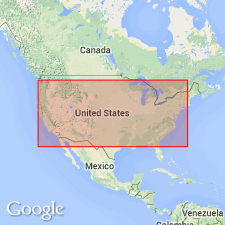
- Usage in publication:
-
- Seneca member
- Modifications:
-
- Revised
- Reinstated
- AAPG geologic province:
-
- Appalachian basin
Summary:
In central NY, a third division of the Onondaga, the Seneca limestone, is a dark shaly rock underlying the Marcellus and containing an abundance of CHONETES LINEATUS, DALMANITES SELENURUS, and large coiled cephalopods. Name Seneca has fallen into disuse, but, because interval it defines is a well-marked unit, it is here revived. Assigned to Onesquethaw stage (new). Seneca is Early or Middle Devonian.
Source: GNU records (USGS DDS-6; Reston GNULEX).
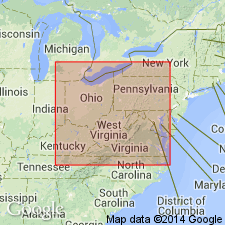
- Usage in publication:
-
- Seneca Member*
- Modifications:
-
- Overview
- AAPG geologic province:
-
- Appalachian basin
Summary:
The Tioga Ash Bed is found in NY at the contact between the Seneca and Moorehouse Members of the Onondaga Limestone.
Source: GNU records (USGS DDS-6; Reston GNULEX).
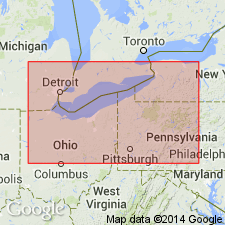
- Usage in publication:
-
- Seneca Limestone Member
- Modifications:
-
- Areal extent
- AAPG geologic province:
-
- Appalachian basin
Summary:
Seneca Member of Onondaga Limestone shown clearly in PA and OH subsurface (fig. 6). Units traced using gamma-ray logs.
Source: GNU records (USGS DDS-6; Reston GNULEX).
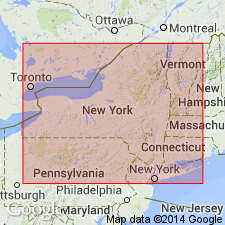
- Usage in publication:
-
- Seneca Member
- Modifications:
-
- Revised
- AAPG geologic province:
-
- Appalachian basin
Summary:
The Seneca-Moorehouse boundary is here revised, based on the section in the Warren Brothers Quarry, 1 mi west of Canoga, NY. Boundary is described as "genetic," defined by a paracontinuous surface correlative with the Venice-Marblehead boundary in the Columbus Limestone of OH. Base of the Seneca as herein defined bears a bone bed which is the correlative of bone bed 1 in southern IN and northwestern KY and bone bed 2 in central OH. Previous workers placed the boundary at Hall's (1843) bentonite (the Onondaga Indian Nation Bentonite of this paper), which is actually 1.9 to 4.10 ft below the base of the Seneca contact with the Moorehouse Member.
Source: GNU records (USGS DDS-6; Reston GNULEX).
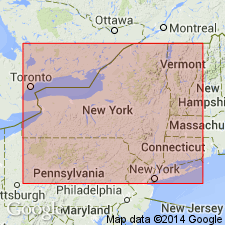
- Usage in publication:
-
- Seneca Member
- Modifications:
-
- Overview
- AAPG geologic province:
-
- Appalachian basin
Summary:
The Seneca Member of the Onondaga Formation, as now defined, is part of a general fining-upward trend that extends from the underlying upper part of the Moorehouse Member into the overlying Marcellus Formation at its type section. Deposition of member is more complex than previously thought as details reveal that it contains two cycles rather than one, indicating two deepening intervals. The upper contact of the Seneca, as defined in this report, is marked by a thin, apparently widespread lag bed with fish bone material. Member is thickest in the central Finger Lakes area. Thins eastward and is eventually cutout near Albany. Contains a relatively low diversity fauna. Chonetid and atrypid brachiopods are abundant and LEPTAENA, common; rugose corals are uncommon. Fine to medium-grained wacke- to packstones dominate the unit. In outcrop appears as thick-bedded to massive limestones separated by thin shaly to bentonitic partings. Light-weathering chert is present mainly in the western region. Thin dark shales increase in number toward the top. Base is marked by the Onondaga Indian Nation Ash (Tioga B of Pennsylvania), which differs from boundary defined by Conkin, who placed the base of the Seneca 0.47 to 1.25 m above the base of the bentonite. As many as eight Tioga Ash Beds may occur in the Seneca Member, including the Tioga B. At the Seneca Stone quarry, 8.5 km northwest of the type section, the member is 7.1 to 8.4 m thick, depending upon placement of the upper contact, and underlies the Bakoven Member of the Union Springs Shale [shown in chart as part of Marcellus subgroup [informal] of the Hamilton Group]. Oliver (1954) labeled the 1.3 m-thick transitional interval "Zone L" and assigned it to the Seneca. Here, authors follow Conkin and Conkin (1979) and assigned this interval to the overlying Union Springs. Age of the Seneca is Middle Devonian (Eifelian).
["Subgroup" not recognized as a formal stratigraphic rank term (CSN, 1933; ACSN, 1961, 1970; NACSN, 1983, 2005, 2021). Considered informal and should not be capitalized.]
Source: Modified from GNU records (USGS DDS-6; Reston GNULEX).
For more information, please contact Nancy Stamm, Geologic Names Committee Secretary.
Asterisk (*) indicates published by U.S. Geological Survey authors.
"No current usage" (†) implies that a name has been abandoned or has fallen into disuse. Former usage and, if known, replacement name given in parentheses ( ).
Slash (/) indicates name conflicts with nomenclatural guidelines (CSN, 1933; ACSN, 1961, 1970; NACSN, 1983, 2005, 2021). May be explained within brackets ([ ]).

